ANICHINI, LUIGI (Ital.). Son of the last, and also a Gem-engraver. He excelled in works of great delicacy and precision. Some medals are said to have been executed by him. From his correspondence, we learn that in 1537, he was still a young man, and that Titian and Sansovino were among his friends. He principally resided at Venice. Old writers mention an Apollo and a Ganymede cut by him, but none of his works has come down to us. Baruffaldi attributes to him medals of Pope Paul III. and Henry II. of France which really belong to Alessandro Cesati.
Source: Biographical dictionary of medallists; coin, gem, and seal-engravers, mint-masters, ancient and modern, with references to their works B.C. 500-A.D. 1900; compiled by L. Forrer, London 1904
Source: Biographical dictionary of medallists; coin, gem, and seal-engravers, mint-masters, ancient and modern, with references to their works B.C. 500-A.D. 1900; compiled by L. Forrer, London 1904
AHLBORN, LEA
AHLBORN, LEA (Swed.). Born in 1826, she was the daughter of the celebrated Engraver Ludwig Persson Lundgren, under whom she learned the art. Amongst her first masters, Johan and Abraham Salmson, then Toussaint and Barre, the Paris sculptor and medallist, are the most conspicuous. In 1853 she succeeded her father as Engraver to the Swedish Mint, a post which she rilled until 1895. She married in 1854 a distinguished sculptor, Karl Ahlborn of Brunswick. Her death took place on the 31. March, 1895....
[ More about AHLBORN, LEA ]
AHLBORN, LEA (Swed.). Born in 1826, she was the daughter of the celebrated Engraver Ludwig Persson Lundgren, under whom she learned the art. Amongst her first masters, Johan and Abraham Salmson, then Toussaint and Barre, the Paris sculptor and medallist, are the most conspicuous. In 1853 she succeeded her father as Engraver to the Swedish Mint, a post which she rilled until 1895. She married in 1854 a distinguished sculptor, Karl Ahlborn of Brunswick. Her death took place on the 31. March, 1895....
[ More about AHLBORN, LEA ]
ACHESON JAMES
ACHESON or ACHESOUN, JAMES (Brit.). Moneyer (or Mint-master) at Edinburgh, 1525-1546, under James V. of Scotland. We read of his receiving on the 12th November 1526 an order to coin gold and silver money, and another, previously, on the 1st March 1525-6. Down to 1538, his name is several times mentioned in the accounts of the Lord High Treasurer under James V. ; it appears that the following year he refused to strike bawbees, ordered on the responsibility of the Laird of Sillebawby ; probably on...
[ More about ACHESON JAMES ]
ACHESON or ACHESOUN, JAMES (Brit.). Moneyer (or Mint-master) at Edinburgh, 1525-1546, under James V. of Scotland. We read of his receiving on the 12th November 1526 an order to coin gold and silver money, and another, previously, on the 1st March 1525-6. Down to 1538, his name is several times mentioned in the accounts of the Lord High Treasurer under James V. ; it appears that the following year he refused to strike bawbees, ordered on the responsibility of the Laird of Sillebawby ; probably on...
[ More about ACHESON JAMES ]
ACHESON, JOHN
ACHESON, JOHN (Brit.), was Master-coiner of the Mint in Scotland in 1555. His family is said to have been connected with the coinage for nearly a century (1525-1620). This artist executed the dies for most of the coins of Mary; the only medal which can be attributed with certainty to him is a silver jeton, or pattern for a half-testoon of 1553, with bust of Mary on obv. and shield of Scotland, between M-R on R. The type of this piece was afterwards adopted for gold Ryals, issued in 1555. The coi...
[ More about ACHESON, JOHN ]
ACHESON, JOHN (Brit.), was Master-coiner of the Mint in Scotland in 1555. His family is said to have been connected with the coinage for nearly a century (1525-1620). This artist executed the dies for most of the coins of Mary; the only medal which can be attributed with certainty to him is a silver jeton, or pattern for a half-testoon of 1553, with bust of Mary on obv. and shield of Scotland, between M-R on R. The type of this piece was afterwards adopted for gold Ryals, issued in 1555. The coi...
[ More about ACHESON, JOHN ]
ACHESON, THOMAS
ACHESON, THOMAS (Brit.), succeeded his father as Master of the Mint of Scotland, under James VI. By act of Parliament, 1580-81, the working of the mint was let for three years to a commission of which " Thomas Aitchesoun " was a member. In 1588 eight-penny and four-penny pieces, were struck which in contemporary documents are styled Achesouns and half-Achesouns " probably from having been the first base coinage made when this Thomas Achesoun was master of the mint, an office which he held from 1...
[ More about ACHESON, THOMAS ]
ACHESON, THOMAS (Brit.), succeeded his father as Master of the Mint of Scotland, under James VI. By act of Parliament, 1580-81, the working of the mint was let for three years to a commission of which " Thomas Aitchesoun " was a member. In 1588 eight-penny and four-penny pieces, were struck which in contemporary documents are styled Achesouns and half-Achesouns " probably from having been the first base coinage made when this Thomas Achesoun was master of the mint, an office which he held from 1...
[ More about ACHESON, THOMAS ]
